Many of us have experienced our cat snuggle up to us only to bite at our hand when we go to pet them. This is one scenario where some cats show aggression to their owners. Many other situations can lead to cats swatting, scratching, or trying to bite their human companions.
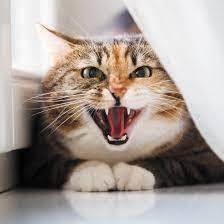
These unwanted behaviors from our feline friends often stem from other reasons. Thus, trying to stop the aggression begins with understanding why it’s happening. Then, you can figure out how to best address the problem behavior.
Below are some different types of feline aggression
Play-related Aggression
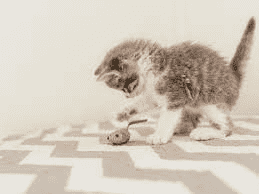
This type of aggression occurs when play winds your cat up too far or when a cat misdirects play behavior. Many owners roughhouse with their cats, especially as kittens, using their hands as objects for the cats to mouth or kick.
While it may seem cute and harmless, it can teach your cat that this is an acceptable type of behavior and is less cute when a 10 pound animal is biting your hands and feet. To prevent this behavior from becoming a problem, use toys as the target. If playing with your cat causes him/her to get too worked-up and escalates to aggression toward you, end the session and walk away or redirect their focus onto another toy.
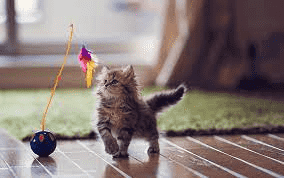
Another sign of play-related aggression is stalking and attacking moving feet. Cats often use predatory behavior when playing, therefore try to redirect your cat to appropriate objects.
Waving wand toys, tossing toy mice or cat-sized balls (even wadded up appropriately sized aluminum foil balls will work) or throwing pieces of kibble across the floor can help satisfy the desire for that predatory style of play.
Petting-induced Aggression
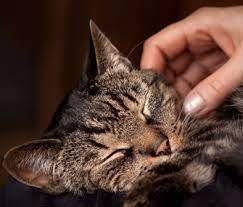
When aggression is triggered by petting, understanding why this happens is the tricky part. It seems like your cat wanted the attention and petting in the first place. Just because your cat wants your attention or closeness doesn’t necessarily mean they want to be petted. Sometimes, cats only want to be near (or on) you without being petted, or maybe they do want to be petted but not in that spot or not for very long.
Keep in mind, that most cats prefer to be petted on the top of the head, cheeks, or under the chin. Many cats do not like long strokes down the back. And most DO NOT WANT THEIR TAIL TOUCHED; like people, every cat has their individual preference. The key is for you to find out what your cat likes and stick to those areas. For cats who only withstand brief moments of petting, try petting for a few seconds and stop.
If they solicit more by nudging or leaning into you, then keep going for a few seconds more. Keep in mind, when cats roll over, this usually doesn’t mean they want you to pet them on their belly. People like to have their physical boundaries respected. Remember to respect your cat’s likes and dislikes.
Defensive or Fear-related Aggression
Cats use aggressive behavior to defend themselves when feeling anxiety or fear. This aggression often includes situations during which the cat is being handled or restrained, such as for nail trims, brushing, veterinary exams, or when there is a potential threat – real or perceived – from another animal or human. Most cats prefer to avoid conflict, but when they cannot, they may use aggression to protect themselves and feel safe.
Cats may be anxious about restraint. If routine handling for grooming or other procedures was not part of their kitten socialization and exposure, they may be anxious in those situations as adults. Preventing this type of aggression can be done by creating positive associations with handling and new people from an early age.
It’s not just about exposing young cats them to these things, it needs to be a positive experience, usually by pairing it with high-value food. If the anxiety or defensive aggression has already started, more focused behavior modification will be needed.
Pain-related Aggression
Physical discomfort can also be a factor in human-directed aggression. Painful cats have a lower tolerance for human interaction. If a previous experience was painful and your cat learned to associate that handling with pain, he/she may be aggressive when handled.
Another example is a cat with severe dental disease or gingival inflammation called stomatitis. Cats with sore, diseased mouths may not want to be touched around their head or chin. Seeking medical/dental treatment for this is the best way to address the underlying cause. As with any type of aggression, but especially with a recent onset, see your veterinarian for a physical examination to search for subtle signs of pain or illness.
Redirected Aggression
This aggression occurs when your cat becomes aroused or highly upset. When that target is inaccessible, they may redirect their aggression onto something else, such as you or another pet. One of the most common scenarios is when a cat sees an outdoor cat on the other side of a window or door, seemingly taunting them.
Because the cat cannot access the intruder, they turn their frustration and aggression to what is closest. With this redirected aggression, you have to identify the trigger and prevent your cat from being exposed to it.
Treatment
Whenever your cat is exhibiting aggression, consult with your veterinarian. Take note of when the aggression occurs and what events precede it. This information, together with an examination, will help your veterinarian determine the next steps. If pain or illness is contributing to the aggression, treatment should start with addressing those issues.
In summary:
- For petting-induced and play-related aggression, changing the way you interact with your cat, and learning your cat’s petting preferences may be needed. Often it is your behavior that needs to be altered.
- If fear and anxiety cause your cat to react defensively, then your cat may need behavior modification. In some cases, medication may be needed to lessen your cat’s anxiety or over-arousal.
- Pain-related aggression – requires veterinary help. If you are easily able to pinpoint the area touched that elicits aggression, that can be helpful
Regardless of the type of aggression or its cause, punishment should never be your response. If your cat is fearful, being punished increases anxiety, potentially making the behavior worse. This is also true if your cat is in a highly aroused state.
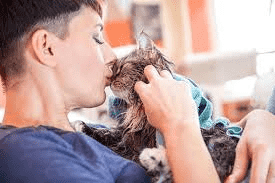
Punishment does not teach the cat what the appropriate behavior is, does not improve the cat’s underlying emotional state, and can often have unintended consequences. Talk with your veterinarian and see how they can work with you to get the bottom of the cause and improve your interactions with your feline companion.


